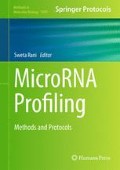Abstract
Human iPS cells are capable of differentiation towards all three germ layer lineages. As well as being of use for the study of developmental biology, these cells also provide an excellent resource for disease modeling and cell replacement therapies. iPS cells derived from an individual with a disease type of interest can be differentiated towards the cell type afflicted in that particular disease. Such differentiated cell types can be used to test patient-specific drug responses in vitro, for generation of replacement cells for transplantation, or as a starting material for gene editing to correct disease-causing mutations/deletions. With such a vast array of potential applications, there is a great need to understand the exact mechanisms controlling the maintenance of pluripotency, and the distinct cues signaling these cells to differentiate towards lineages of interest. This chapter focuses on microRNA profiling using TaqMan Human MicroRNA Arrays to examine expression of 754 miRNAs in human iPS cells in the pluripotent state, and iPS derived definitive endoderm.
Access this chapter
Tax calculation will be finalised at checkout
Purchases are for personal use only
References
Takahashi K, Yamanaka S (2006) Induction of pluripotent stem cells from mouse embryonic and adult fibroblast cultures by defined factors. Cell 126(4):663–676
Takahashi K, Tanabe K, Ohnuki M, Narita M, Ichisaka T, Tomada K, Yamanaka S (2007) Induction of pluripotent stem cells from adult human fibroblasts by defined factors. Cell 131(5):861–872
Robinton DA, Daley GQ (2012) The promise of pluripotent stem cells in research and therapy. Nature 481:295–305
Wells JM, Melton DA (1999) Vertebrate endoderm development. Annu Rev Cell Dev Biol 15:393–410
Unternaehrer JJ, Daley GQ (2011) Induced pluripotent stem cells for modelling human diseases. Philos Trans R Soc Lond B Biol Sci 366(1575):2274–2285
Bartel DP (2004) MicroRNAs: genomics, biogenesis, mechanism, and function. Cell 116:281–297
Choi YJ, Lin CP, Ho JJ, He X, Okada N, Bu P, Zhong Y, Kim SY, Bennett MJ, Chen C, Ozturk A, Hicks GG, Hannon GJ, He L (2011) Mir-34 miRNAs provide a barrier for somatic cell reprogramming. Nat Cell Biol 13:1253–1260
Melton C, Judson RL, Blelloch R (2010) Opposing microRNA families regulate self-renewal in mouse embryonic stem cells. Nature 463:621–626
Subramanyam D, Lamouille S, Judson RL, Liu JY, Bucay N, Derynck R, Blelloch R (2011) Multiple targets of mir-302 and mir-372 promote reprogramming of human fibroblasts to induced pluripotent stem cells. Nat Biotechnol 29:443–448
Judson RL, Babiarz JE, Venere M, Blelloch R (2009) Embryonic stem cell-specific microRNAs promote induced pluripotency. Nat Biotechnol 27:459–461
D’Amour KA, Agulnick AD, Eliazer S, Kelly OG, Kroon E, Baetge EE (2005) Efficient differentiation of human embryonic stem cells to definitive endoderm. Nat Biotechnol 23(12):1534–1541
D’Amour KA, Bang AG, Eliazer S, Kelly OG, Agulnick AD, Smart NG, Moorman MA, Kroon E, Carpenter MK, Baetge EE (2006) Production of pancreatic hormone-expressing endocrine cells from human embryonic stem cells. Nat Biotechnol 24(11):1392–1401
Author information
Authors and Affiliations
Corresponding author
Editor information
Editors and Affiliations
Rights and permissions
Copyright information
© 2017 Springer Science+Business Media New York
About this protocol
Cite this protocol
Hennessy, E. (2017). MiRNA Profiling in Human Induced Pluripotent Stem Cells. In: Rani, S. (eds) MicroRNA Profiling. Methods in Molecular Biology, vol 1509. Humana Press, New York, NY. https://doi.org/10.1007/978-1-4939-6524-3_6
Download citation
DOI: https://doi.org/10.1007/978-1-4939-6524-3_6
Published:
Publisher Name: Humana Press, New York, NY
Print ISBN: 978-1-4939-6522-9
Online ISBN: 978-1-4939-6524-3
eBook Packages: Springer Protocols

